Life-Saving Craft Aboard Ocean Liners - 1912
Introduction
The sinking of the RMS Titanic in April 1912, one of the deadliest maritime disasters in history, exposed significant gaps in the safety provisions of ocean liners, particularly concerning lifeboat capacity. The article "Life-Saving Craft Aboard Ocean Liners - 1912" from The Illustrated London News sheds light on the inadequate number of lifeboats and other life-saving craft on the Titanic and other contemporary vessels. It discusses how the disaster prompted urgent reassessment and reform of maritime safety regulations. The article highlights the stark contrast between the lifeboat capacities required by regulations and the actual needs of passengers and crew. It also critiques the insufficient lifeboat drills and lack of disciplined seamanship among crew members on passenger liners, advocating for improved safety practices. This examination underscores the need for comprehensive reforms to prevent such a tragedy from occurring again.
Boats Carried, and Boats Needed to Save All: Vital Figures.
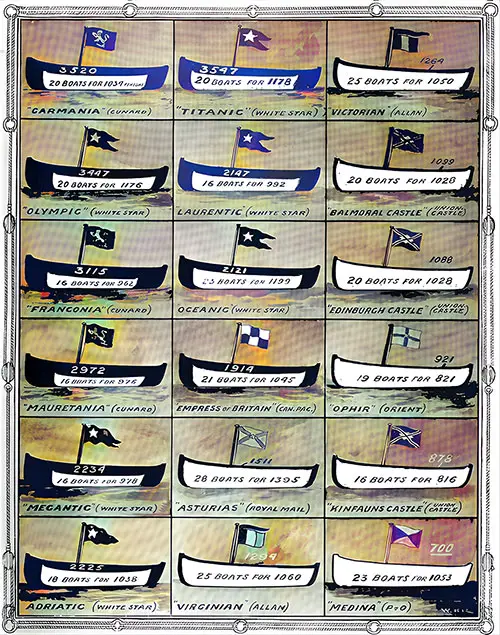
Liners and Their Lifesaving Craft before the Disaster: White Boats to Represent the Number of Persons for Whom Boats Were Carried; Black to Represent the Boats Required for the Ships' Full Complements. The Illustrated London News (11 May 1912) p. 689. | GGA Image ID # 100814f3ab
As noted, the white boats indicate the number of passengers for whom lifesaving craft, etc., were provided; the black boats indicate the number who would have to be provided if arrangements were made for all.
Thus, the "Titanic" had twenty boats capable of holding 1178, while she was certified to carry 3547 passengers and crew. It's important to note that the Board of Trade, a regulatory body responsible for setting maritime safety standards, requires every vessel to have a certain number of lifesaving craft, including lifebelts and lifebuoys, which is over and above the number of passengers for whom they are provided.
Therefore, it's important to note that no blame can be attached to the industry. In fact, given the fresh experience of the Titanic disaster, it's inevitable that every line will increase the number of its boats and other safety measures. Some have already done so, and this trend suggests a hopeful future for maritime safety.
The figures given above are those supplied by the Board of Trade. By the time they are published here, one will have likely made alterations in many instances.
Again, boats are not the only lifesaving devices—the "Titanic" also had, for example, 3560 lifebelts and forty-eight lifebuoys.
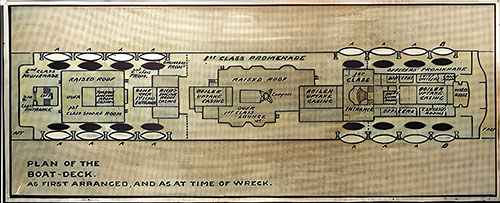
The Boats the "Titanic" Carried and Those She Might Have Carried: The Ill-Fated Liner's Boat-Deck as Planned and as It Was at the Time of the Disaster. The Illustrated London News (11 May 1912) p. 691. | GGA Image ID # 10086f3baa
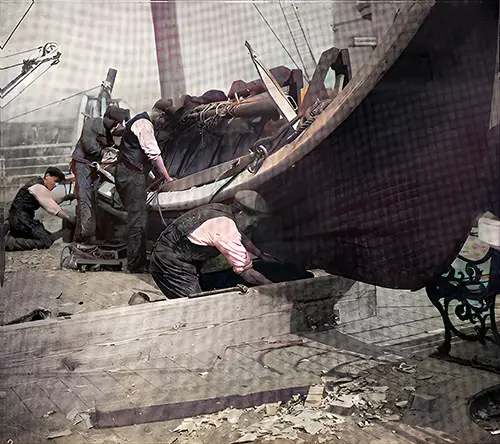
The Lesson Learnt after the Greatest Maritime Disaster: Fitting-Up a Collapsible Boat Aboard the Olympic. The Illustrated London News (11 May 1912) p. 691. | GGA Image ID # 1008a4f2da
A paper read at Glasgow some while ago contained the following: "The two White Star Liners, the 'Titanic' and 'Olympic'. . . are also to be fitted with this same type of double-acting davits [the Welin Quadrant Davit]. Each vessel will carry sixteen sets, enough davits to handle thirty-two lifeboats.
All inboard boats on these ships are extra boats fitted in addition to the regulation complement. The "Titanic" was so fitted that it could have carried thirty-two lifeboats instead of the sixteen she did carry under davits.
Four collapsible lifeboats were added to the liner's lifesaving craft when White Star Line decided not to have inboard lifeboats in addition to those under davits, which, it must be said, fully complied with the Board of Trade regulations.
The diagram shows the boats carried under davits in white, which might have been brought in addition and handled by the same davits in black.
Orders have now been given that, Board of Trade Regulations notwithstanding, no ship of the International Mercantile Marine Company, which includes the White Star Line, the American, the Red Star, Dominion, Leyland, and Atlantic Transport, shall go to sea without boats and rafts for the whole of the passengers and crew. Other companies are following suit.
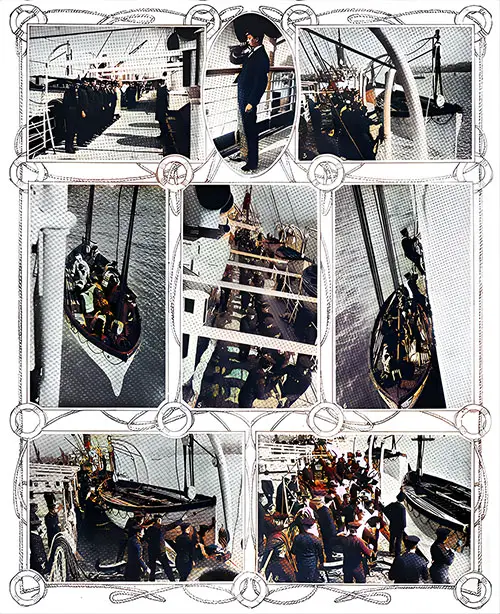
Lifeboat Drill on a Steamship: As It Should Be on Every Liner. The Illustrated London News (11 May 1912) p. 698. | GGA Image ID # 1008b55b11
Top Row:
- Boat-Drill on a Liner: Crews, Each Including a Cook, Lined up by the Sides of the Boats Allotted to Them, Ready to Operate Them at the Word of Command.
- The Alarm Sounding the Bugle-Call for the Crews to Muster and Man Their Boats.
- Practice in Life-Saving on a Liner: Crews Swing Lifeboats out from the Davits Preparatory to lower them to the Water.
Middle Row
- With Her Crew in Their Cork Jackets: A Boat Swinging from the Davits. Half—Way Toward the Water
- Nearing the End of Boat Drill, Hauling a Boat up a Liner's Side
- A Boat Safely on the Water
Bottom Row
- Beginning to Swing Boats out for Lowering.
- Putting on Cork Jackets before Crewing the Boats.
Taking the "Titanic" disaster as a text, but, of course, without definite knowledge of what happened, there are those who suggest that on some passenger-carrying vessels, at all events, far too little attention is paid to boat drills.
They state further that on particular liners, there needs to be more seamanship among the men who, because of the nature of the vessels on which they sail, are attendants rather than seamen in too many cases.
Dealing with this subject, Mr. Gerard Fiennes, writing in the "Pall Mall Gazette," says: "It is absurd to suppose that the same degree of discipline and training can exist in the mercantile marine as in the Navy.
If the call comes to take the crew off a stricken warship, only disciplined men must be dealt with. On board the liner, there is a crowd of first, second, and third-class passengers subjected to no discipline.
On board a liner, even if lifeboats are sufficient and a certain amount of boat drill, more or less superficial, takes place, none of the passengers are told off to particular boats. It is terrific, under the circumstances, that the crew got as many as 700 safely away from the 'Titanic.'
Next to the sufficiency of the boats carried in point of number, the most critical matter is that there should be sufficient officers and an adequate number of seamen to staff them."
The Saving of the 705: Uncrowded Lifeboats of the "Titanic"
Photographs, Taken by a Passenger on the "Carpathia," Reproduced by Courtesy of "Collier's Weekly."
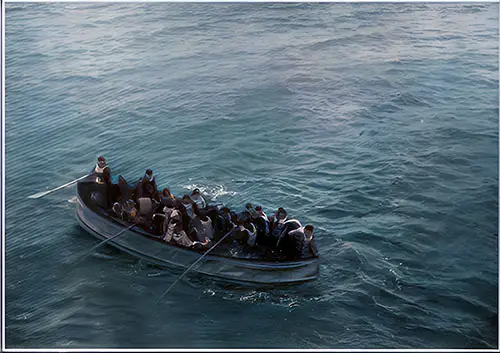
Survivors Aboard a Collapsible from the "Titanic," the Boat Being Rowed Slowly Towards the "Carpathia," Immediately before the Rescue of the Passengers. The Illustrated London News (18 May 1912) p. 734. | GGA Image ID # 1008b6f007
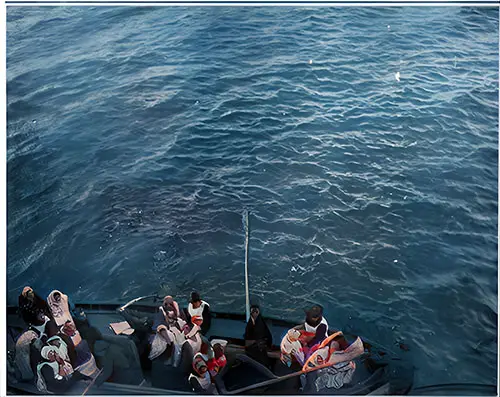
Drawing Alongside the "Carpathia" to Be Picked Up, Survivors of the "Titanic" Disaster, Mostly Women, in One of the Ill-Fated Liner's Less Crowded Life Boats. The Illustrated London News (18 May 1912) p. 734. | GGA Image ID # 10091c4c07
A "Carpathia" steward describing the rescue of "Titanic" survivors to the "Times." said of the coming of the first boat of passengers: "Just as it was about a half-day, we came upon a boat with eighteen men in it, but no women. It was not more than a third filled. Between 8:15 and 8:30, we got the last two boats, crowded to the gunwale. Almost all the occupants were women."
The work of getting the passengers over the side of the "Carpathia" was attended by the most heartrending scenes. Mr. Kuhl of Nebraska said: "Dawn was breaking when the Carpathia's passengers were awakened by the excitement of coming upon a fleet of lifesaving boats. The babies were crying, many of the women were hysterical while the men were stolid and speechless."
Saved by "SOS" - "Titanic" Survivors in the Life-Boats.
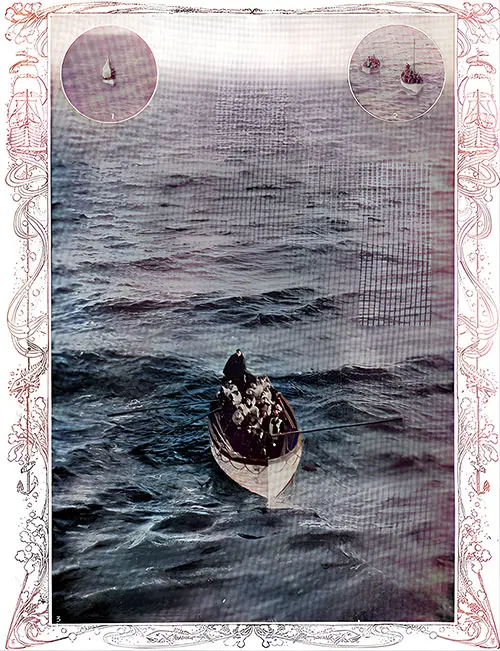
Saved by SOS. "Titanic" Survivors in the Lifeboats. The Illustrated London News (18 May 1912) p. 735. | GGA Image ID # 100a01e0ea
The "Carpathia" arrived on the scene of the "Titanic" disaster in answer to the wireless distress signal "SOS." Not in time to see the end of the great liner, but in time to pick up her boats and take the 705 survivors to New York.
A "Carpathia" passenger described the rescue to the "Times: "I went up onto the deck and found that our vessel had changed course. The lifeboats had been sighted and began to arrive one by one.
There were sixteen of them in all. The transfer of the passengers was soon being carried out.
It was a tragic sight. Ropes were tied around the waists of the adults to help them climb up the rope ladders. Little children and babies were hoisted onto our deck in bags. Some boats were crowded, but a few were not half full.
There were husbands without their wives, wives without their husbands, parents without their children, and children without their parents. Still, there was no demonstration, and no sob was heard. They spoke scarcely a word. They seemed stunned/shocked by their experiences."
Drawn from Material Supplied by Mrs. Cornell, a Survivor.

A Seaman, a Foreigner — and Women: The Crew and Passengers of One of the "Titanic's "Life-Boats after the Disaster. Drawn from Material Supplied by Mrs. Cornell, a Survivor. (Proof of the Discipline Aboard the Sinking "Titanic": A Boat 'Load of Women.) The Illustrated London News (18 May 1912) p. 754. | GGA Image ID # 100a0cd3ea
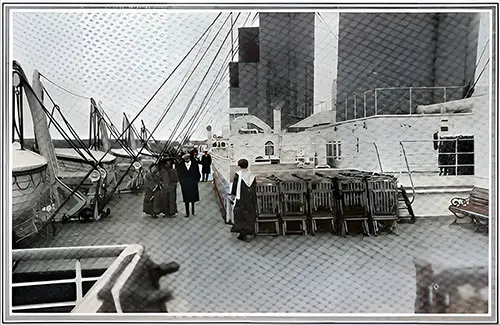
Passing Lifeboats in Which Survivors of the Disaster Subsequently Escaped: Passengers on the Boat-Deck of the "Titanic" in Cork Harbor. The Illustrated London News (4 May 1912) p. 635. | GGA Image ID # 1007f31e01
The Ill-fated "Titanic" left Southampton on her disastrous maiden voyage to New York at noon on 10 April and first crossed to Cherbourg, where some passengers came on board.
She then proceeded to Queenstown (Cobh), another port of call for American mall steamers in Cork Harbor. She arrived there shortly before noon on the 11th and left at 1:30, having on board 316 saloon passengers, 279 in the second class, 698 in the steerage, and a crew of 903.
The above photograph was taken while the vessel lay in Cork Harbour and shows some of the passengers who were destined, three days later, to undergo such terrible experiences. On the left may be some of the ship's boats, from which survivors escaped.
"The Titanic," in Collier's: The National Weekly, New York: F. F. Collier & Son, Incorporated, Publishers, Vol. XLIX, No., 7, Saturday, 4 May 1912, p. 7.
Pictorial from The Illustrated London News demonstrates the role of lifeboats on the Titanic and other ships of that era, along with the effects of shortchanging passengers with too few lifeboats.
Key Points
-
Inadequate Lifeboat Capacity on the Titanic and Other Liners:
- Before the Titanic disaster, lifeboat provisions on many ocean liners were insufficient, adhering only to the outdated requirements set by regulatory bodies like the British Board of Trade. The Titanic, for example, carried only 20 lifeboats, enough for 1,178 people, despite having a certified capacity for 3,547 passengers and crew.
- Visual illustrations in the article contrast the number of lifeboats carried by ships like the Titanic with the number needed for the total complement of passengers, highlighting the critical shortfall in lifeboat availability.
-
Potential for Increased Lifeboat Capacity:
- The article points out that the Titanic and its sister ship, the Olympic, were equipped with Welin Quadrant Davits, which could handle up to 32 lifeboats. However, the Titanic only carried 16 lifeboats under davits, plus four collapsible boats, well below the potential capacity.
- Following the disaster, there was a shift in policy. The White Star Line and other companies ordered that all ships under their operation carry enough lifeboats and rafts for every passenger and crew member on board, irrespective of existing regulations.
-
Deficiencies in Lifeboat Drills and Crew Training:
- The article highlights a lack of regular lifeboat drills and insufficient training among crew members on many passenger ships. The Titanic’s crew was relatively unprepared, leading to a disorganized evacuation process.
- Commentary by Gerard Fiennes in the Pall Mall Gazette underscores the difference between the disciplined operations of a military vessel and the often chaotic procedures on passenger liners, where the crew and passengers lack coordinated emergency training.
-
Reforms and Increased Safety Measures After the Titanic Disaster:
- The tragedy acted as a catalyst for significant reforms in maritime safety. New orders were issued that all ships of the International Mercantile Marine Company, which included the White Star Line, must be equipped with sufficient lifeboats for all aboard, regardless of the existing Board of Trade regulations.
- Other measures included fitting additional collapsible lifeboats and improving the quality and frequency of lifeboat drills on ships to ensure better preparedness in emergencies.
-
Photographic Evidence and Eyewitness Accounts:
- The article provides photographs of lifeboat drills, survivors in lifeboats, and the rescue operations conducted by the RMS Carpathia. These images underscore the importance of having adequate lifeboats and trained personnel to manage them.
- Eyewitness accounts from the Carpathia detail the emotional toll of the rescue, the crowded and under-filled lifeboats, and the challenging conditions faced by the survivors, reinforcing the need for better safety measures.
-
Call for Improved International Maritime Standards:
- The article concludes with a call for international standardization of safety regulations, including lifeboat requirements, passenger capacity, and crew training. It emphasizes that no liner should go to sea without proper life-saving equipment and protocols to protect everyone on board.
Summary
The article "Life-Saving Craft Aboard Ocean Liners - 1912" provides a critical examination of the lifeboat provisions on ocean liners during the early 20th century, with a focus on the Titanic disaster. It reveals the severe inadequacy of lifeboats and other life-saving equipment relative to the number of passengers and crew on board and discusses the resulting push for reform. The article highlights the discrepancies between regulatory requirements and actual safety needs, the deficiencies in crew training and lifeboat drills, and the changes made by shipping companies in the aftermath of the disaster. The photographs and eyewitness accounts included in the article vividly illustrate the urgent need for comprehensive improvements in maritime safety practices.
Conclusion
The tragic loss of life aboard the RMS Titanic was a turning point in maritime safety, compelling the world to confront the dangerous inadequacies of the time. As detailed in "Life-Saving Craft Aboard Ocean Liners - 1912," the disaster underscored the need for more lifeboats, better crew training, and rigorous safety drills on all ocean liners. The subsequent reforms by shipping companies and regulatory bodies reflected a newfound commitment to passenger safety, driven by the hard lessons learned from the Titanic. The changes adopted after this tragedy paved the way for more robust international standards in maritime safety, ensuring that every passenger and crew member on future voyages would have a much better chance of survival in the event of an emergency. The article serves as a reminder that while progress has been made, vigilance and continued improvement are essential to safeguarding lives at sea.
